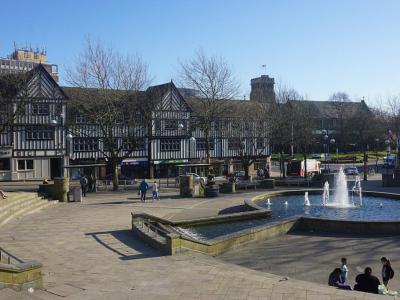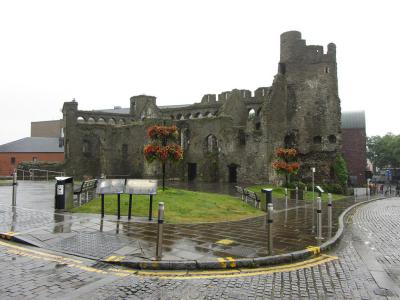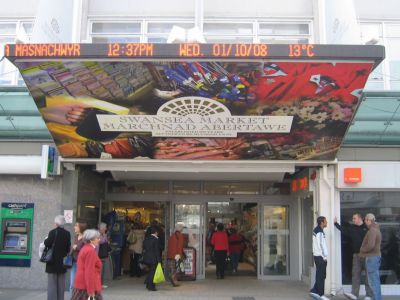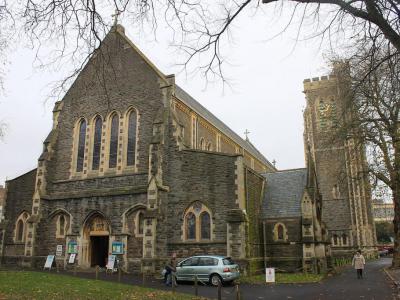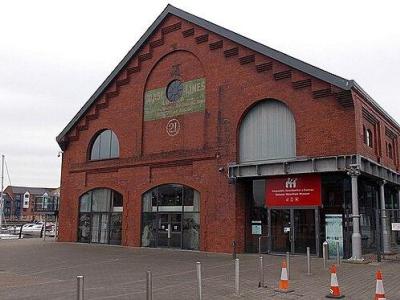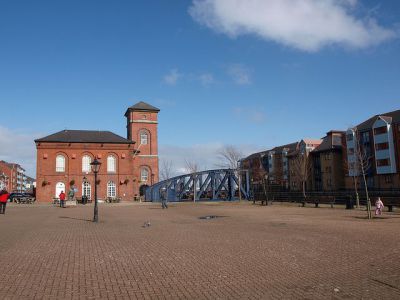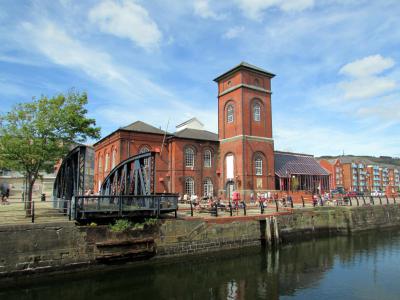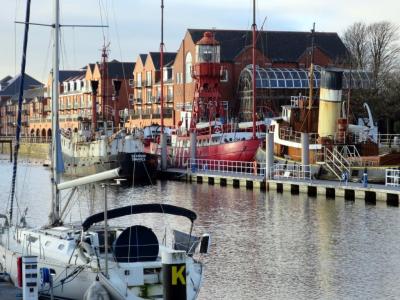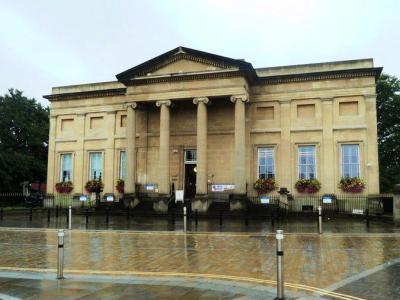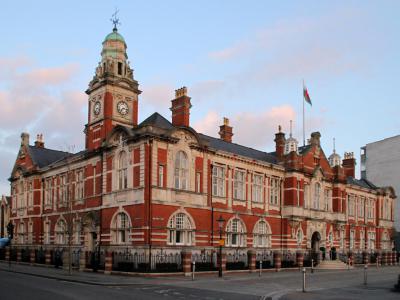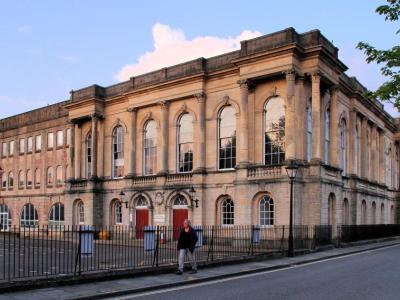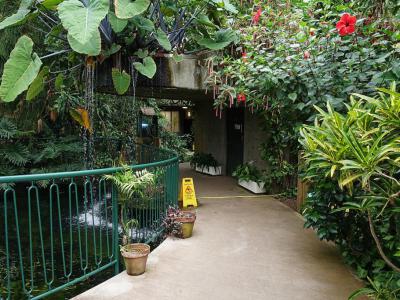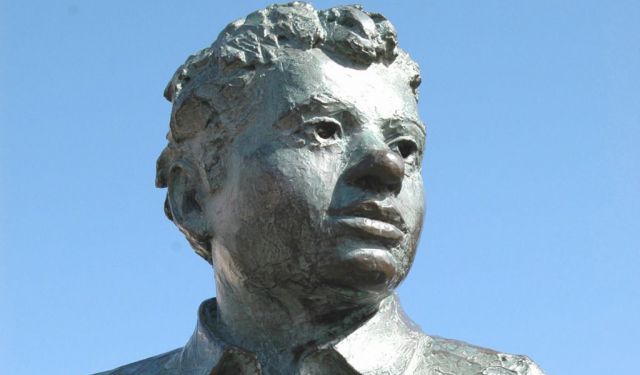Swansea Introduction Walking Tour (Self Guided), Swansea
Swansea, the city on the southwest coast of Wales, is the country's second-largest. Its original name in Welsh – Abertawe – means 'mouth of the Tawe' and hints at its geographic location and historical ties to the River Tawe.
The area's history dates back to ancient times when it was contested by early Welsh kingdoms. During the Viking Age, it became a significant trade hub. The city's present name derives from Old Norse, specifically from the Viking king Sweyn Forkbeard. After the Norman Invasion, Henry de Beaumont, 1st Earl of Warwick, took over the land, where he built Swansea Castle, around 1106, and began minting coins called Swensi.
In the 18th and 19th centuries, Swansea became a global leader in copper smelting, utilizing ores from across the world and benefiting from its strategic location along the river and nearby coalfields. By the late 1800s, the city, nicknamed "Copperopolis," housed over 600 furnaces and operated a fleet of 500 ships.
In the 20th century, Swansea's heavy industries declined, leaving the Lower Swansea Valley in disarray. During WWII, the city also suffered extensive damage from German bombing. After the war, much of the toxic and polluted land along the river was reclaimed. By the 1980s, grasses and plants introduced to the area changed its landscape into a green valley and created modern developments like the Swansea Marina.
Castle Square, the focal point of the city center, often buzzes with energy, hosting events that bring together locals and visitors alike. Just a stone’s throw away, the remains of the stoic Swansea Castle whisper stories of the city's medieval yesteryear.
A stroll further reveals more than just remnants of the past but a bustling commercial scene as well. Swansea Market, the largest indoor market in Wales, serves as a culinary haven, where fresh Welsh produce and local delicacies like laverbread and Welsh cakes abound.
For those intrigued by industrial heritage, the National Waterfront Museum offers an interactive journey through Wales’ industrial past.
Meanwhile, literary enthusiasts will find a special connection in Dylan Thomas Square, named after Swansea’s most famous son. The Dylan Thomas Centre, in turn, provides comprehensive insights into the poet's life and works.
Swansea’s ability to maintain its historical essence while dynamically engaging with the present is what makes it a compelling destination. The city invites you to explore its streets, soak in its history, and create your own memories. So why wait? Plan your visit now and let your Welsh adventure begin!
The area's history dates back to ancient times when it was contested by early Welsh kingdoms. During the Viking Age, it became a significant trade hub. The city's present name derives from Old Norse, specifically from the Viking king Sweyn Forkbeard. After the Norman Invasion, Henry de Beaumont, 1st Earl of Warwick, took over the land, where he built Swansea Castle, around 1106, and began minting coins called Swensi.
In the 18th and 19th centuries, Swansea became a global leader in copper smelting, utilizing ores from across the world and benefiting from its strategic location along the river and nearby coalfields. By the late 1800s, the city, nicknamed "Copperopolis," housed over 600 furnaces and operated a fleet of 500 ships.
In the 20th century, Swansea's heavy industries declined, leaving the Lower Swansea Valley in disarray. During WWII, the city also suffered extensive damage from German bombing. After the war, much of the toxic and polluted land along the river was reclaimed. By the 1980s, grasses and plants introduced to the area changed its landscape into a green valley and created modern developments like the Swansea Marina.
Castle Square, the focal point of the city center, often buzzes with energy, hosting events that bring together locals and visitors alike. Just a stone’s throw away, the remains of the stoic Swansea Castle whisper stories of the city's medieval yesteryear.
A stroll further reveals more than just remnants of the past but a bustling commercial scene as well. Swansea Market, the largest indoor market in Wales, serves as a culinary haven, where fresh Welsh produce and local delicacies like laverbread and Welsh cakes abound.
For those intrigued by industrial heritage, the National Waterfront Museum offers an interactive journey through Wales’ industrial past.
Meanwhile, literary enthusiasts will find a special connection in Dylan Thomas Square, named after Swansea’s most famous son. The Dylan Thomas Centre, in turn, provides comprehensive insights into the poet's life and works.
Swansea’s ability to maintain its historical essence while dynamically engaging with the present is what makes it a compelling destination. The city invites you to explore its streets, soak in its history, and create your own memories. So why wait? Plan your visit now and let your Welsh adventure begin!
How it works: Download the app "GPSmyCity: Walks in 1K+ Cities" from Apple App Store or Google Play Store to your mobile phone or tablet. The app turns your mobile device into a personal tour guide and its built-in GPS navigation functions guide you from one tour stop to next. The app works offline, so no data plan is needed when traveling abroad.
Swansea Introduction Walking Tour Map
Guide Name: Swansea Introduction Walking Tour
Guide Location: Wales » Swansea (See other walking tours in Swansea)
Guide Type: Self-guided Walking Tour (Sightseeing)
# of Attractions: 12
Tour Duration: 2 Hour(s)
Travel Distance: 2.7 Km or 1.7 Miles
Author: HelenF
Sight(s) Featured in This Guide:
Guide Location: Wales » Swansea (See other walking tours in Swansea)
Guide Type: Self-guided Walking Tour (Sightseeing)
# of Attractions: 12
Tour Duration: 2 Hour(s)
Travel Distance: 2.7 Km or 1.7 Miles
Author: HelenF
Sight(s) Featured in This Guide:
- Castle Square
- Swansea Castle
- Swansea Market
- St. Mary's Church
- National Waterfront Museum
- Dylan Thomas Square
- Pump House
- Swansea Marina
- Swansea Museum
- Morgans Hotel
- Dylan Thomas Centre
- Plantasia
1) Castle Square
Castle Square is a location steeped in history and vibrant with modern-day activity. Originally a small, round hill during the Norman period, it has seen many historical moments, including significant damage during World War II when it was bombarded. Despite its tumultuous past, the square has transformed into one of Swansea's most lively spots, bustling with activity and offering a variety of attractions.
Today, Castle Square is the epicenter of Swansea's open-air events. Its central location makes it the obvious choice for hosting the city's most important gatherings. Whether it's a lively concert or a bustling fair, there's always something happening in Castle Square to capture the interest of residents and visitors alike. The square's layout, adorned with trees and flower baskets, provides a pleasant atmosphere for relaxation. Visitors can often be found enjoying a moment of tranquility on one of the many benches scattered throughout the area.
Throughout the year, Castle Square hosts a wide range of events. From seasonal fairs where unique treasures can be found to music concerts that draw crowds from all over, the square is a hub of entertainment. These events not only enliven the square but also contribute to the cultural and social fabric of Swansea. The constant flow of activities ensures that Castle Square remains a dynamic and engaging place to visit.
In addition to its eventful calendar, Castle Square's charming setting makes it a delightful place to spend time. The greenery and floral displays add a touch of nature to the urban environment, making it a welcoming spot for both relaxation and socializing.
Today, Castle Square is the epicenter of Swansea's open-air events. Its central location makes it the obvious choice for hosting the city's most important gatherings. Whether it's a lively concert or a bustling fair, there's always something happening in Castle Square to capture the interest of residents and visitors alike. The square's layout, adorned with trees and flower baskets, provides a pleasant atmosphere for relaxation. Visitors can often be found enjoying a moment of tranquility on one of the many benches scattered throughout the area.
Throughout the year, Castle Square hosts a wide range of events. From seasonal fairs where unique treasures can be found to music concerts that draw crowds from all over, the square is a hub of entertainment. These events not only enliven the square but also contribute to the cultural and social fabric of Swansea. The constant flow of activities ensures that Castle Square remains a dynamic and engaging place to visit.
In addition to its eventful calendar, Castle Square's charming setting makes it a delightful place to spend time. The greenery and floral displays add a touch of nature to the urban environment, making it a welcoming spot for both relaxation and socializing.
2) Swansea Castle
Swansea Castle, founded by Henry de Beaumont in 1106, stands as a testament to centuries of history in Swansea. Originally established as the center of the lordship of Gower, the castle was designed with a sub-rectangular enclosure overlooking the River Tawe, complemented by an outer bailey that extended to the north, west, and south. The strategic location and design of the castle provided a commanding view of the surrounding landscape, which was crucial for defense and control of the region.
Over the years, Swansea Castle faced numerous conflicts, culminating in its capture in 1217. However, it was restored to English control in 1220 as part of a settlement between Llywelyn ap Iorwerth and Henry III of England. This restoration saw the construction of stone walls and at least one tower within the inner castle. By the late 13th or early 14th century, the outer bailey was also fortified with stone walls, enhancing the castle's defensive capabilities.
In the 18th and 19th centuries, the castle's role evolved from a military stronghold to a civic center. Parts of the castle were repurposed as a market, town hall, drill hall, and even a prison. These changes reflect the castle's adaptability to the shifting needs of the community over time. The 20th century saw further alterations, including the demolition of parts of the interior to make way for modern developments like a newspaper office.
Today, the remaining structures of Swansea Castle have been consolidated and opened to the public, allowing visitors to explore its rich history and appreciate its architectural evolution.
Over the years, Swansea Castle faced numerous conflicts, culminating in its capture in 1217. However, it was restored to English control in 1220 as part of a settlement between Llywelyn ap Iorwerth and Henry III of England. This restoration saw the construction of stone walls and at least one tower within the inner castle. By the late 13th or early 14th century, the outer bailey was also fortified with stone walls, enhancing the castle's defensive capabilities.
In the 18th and 19th centuries, the castle's role evolved from a military stronghold to a civic center. Parts of the castle were repurposed as a market, town hall, drill hall, and even a prison. These changes reflect the castle's adaptability to the shifting needs of the community over time. The 20th century saw further alterations, including the demolition of parts of the interior to make way for modern developments like a newspaper office.
Today, the remaining structures of Swansea Castle have been consolidated and opened to the public, allowing visitors to explore its rich history and appreciate its architectural evolution.
3) Swansea Market (must see)
Swansea Market, located in the heart of Swansea city centre, stands as the largest indoor market in Wales. Its impressive steel and glass roof, featuring an arched portal frame, was designed by Percy Edwards and completed in 1960. This market, which replaced a previous structure destroyed in World War II bombing raids, is the fourth iteration to occupy the site over 200 years. The market’s history dates back to the Middle Ages, underscoring its long-standing role as a commercial hub in Swansea.
The market's diverse offerings include a wide range of stalls selling fresh fruits and vegetables, meats, fish, and clothes. Visitors can also enjoy various cafes and fast food options. Notably, Swansea Market is renowned for its local and continental delicacies, such as Welsh laverbread, Penclawdd cockles, Gower Saltmarsh lamb, and Welsh Black beef, alongside an assortment of continental cheeses.
Adjacent to the market is the Quadrant Shopping Centre, adding to the area's bustling commercial atmosphere. The market not only serves as a vital economic center but also as a cultural touchstone, reflecting Swansea’s rich culinary and historical traditions.
The market's diverse offerings include a wide range of stalls selling fresh fruits and vegetables, meats, fish, and clothes. Visitors can also enjoy various cafes and fast food options. Notably, Swansea Market is renowned for its local and continental delicacies, such as Welsh laverbread, Penclawdd cockles, Gower Saltmarsh lamb, and Welsh Black beef, alongside an assortment of continental cheeses.
Adjacent to the market is the Quadrant Shopping Centre, adding to the area's bustling commercial atmosphere. The market not only serves as a vital economic center but also as a cultural touchstone, reflecting Swansea’s rich culinary and historical traditions.
4) St. Mary's Church
St. Mary’s Collegiate and Parish Church, an Anglican place of worship, boasts a rich history that stretches back to circa 1328, when the original church was erected by Henry de Gower, Bishop of St David's. Over the centuries, the church has endured several significant changes and challenges. In 1739, the roof of the nave collapsed one Sunday morning, but fortunately, it occurred before the congregation arrived, preventing any injuries. The church was rebuilt shortly thereafter, though the original tower was preserved.
By 1822, St. Mary’s Church had been illuminated by gas, marking a modern advancement for the time. The church underwent substantial renovations between 1879 and 1882 under the guidance of Vicar Dr. Morgan. However, it was in 1896 that a major transformation occurred when the church was demolished and rebuilt according to the designs of Arthur Blomfield, commissioned by Dean Allan Smith. Despite this extensive redevelopment, some elements of the old church were retained.
The church's resilience was tested again during World War II. In February 1941, St. Mary’s suffered severe damage during the Blitz. Reconstruction did not commence until the 1950s, demonstrating the church's enduring significance to the community despite the wartime devastation.
Adding to its historical narrative, St. Mary’s has a unique local anecdote: from the 1890s, a figure known as the Swansea Devil stood on a set of buildings facing the west side of the church. This was a result of a disgruntled rival of Blomfield's, who was upset that his designs were not chosen. The Swansea Devil is a curious footnote in the church’s storied past, reflecting the sometimes contentious nature of architectural and civic development.
By 1822, St. Mary’s Church had been illuminated by gas, marking a modern advancement for the time. The church underwent substantial renovations between 1879 and 1882 under the guidance of Vicar Dr. Morgan. However, it was in 1896 that a major transformation occurred when the church was demolished and rebuilt according to the designs of Arthur Blomfield, commissioned by Dean Allan Smith. Despite this extensive redevelopment, some elements of the old church were retained.
The church's resilience was tested again during World War II. In February 1941, St. Mary’s suffered severe damage during the Blitz. Reconstruction did not commence until the 1950s, demonstrating the church's enduring significance to the community despite the wartime devastation.
Adding to its historical narrative, St. Mary’s has a unique local anecdote: from the 1890s, a figure known as the Swansea Devil stood on a set of buildings facing the west side of the church. This was a result of a disgruntled rival of Blomfield's, who was upset that his designs were not chosen. The Swansea Devil is a curious footnote in the church’s storied past, reflecting the sometimes contentious nature of architectural and civic development.
5) National Waterfront Museum (must see)
The National Waterfront Museum is a striking blend of old and new, situated as part of the National Museum Wales and serving as an Anchor Point of the European Route of Industrial Heritage. The museum's design integrates a contemporary slate and glass structure with a historic Grade II listed warehouse, formerly the Swansea Industrial and Maritime Museum. This fusion of architectural styles symbolizes Wales' rich industrial past while embracing modernity.
Opened in October 2005, the museum showcases the history of Wales' industrial revolution and innovation through a diverse range of historical artifacts and cutting-edge technology. Its exhibits include maritime, transport, technology, and retail artifacts, presented with interactive touchscreens and multimedia systems designed by Wilkinson Eyre and Land Design Studio. The project, managed by Davis Langdon, aimed to make the museum accessible to all visitors, featuring multilingual voiceovers and British Sign Language captioning on interactive content.
The museum's commitment to accessibility and modern presentation has made it a pioneer among UK museums. With support from the Welsh Development Agency and the Heritage Lottery Fund, it stands as a testament to Wales' industrial heritage and its ongoing innovation.
Opened in October 2005, the museum showcases the history of Wales' industrial revolution and innovation through a diverse range of historical artifacts and cutting-edge technology. Its exhibits include maritime, transport, technology, and retail artifacts, presented with interactive touchscreens and multimedia systems designed by Wilkinson Eyre and Land Design Studio. The project, managed by Davis Langdon, aimed to make the museum accessible to all visitors, featuring multilingual voiceovers and British Sign Language captioning on interactive content.
The museum's commitment to accessibility and modern presentation has made it a pioneer among UK museums. With support from the Welsh Development Agency and the Heritage Lottery Fund, it stands as a testament to Wales' industrial heritage and its ongoing innovation.
6) Dylan Thomas Square
Dylan Thomas Square, situated in Swansea's Maritime Quarter, stands as a vibrant tribute to one of Wales' most celebrated literary figures. Named in honor of the renowned poet Dylan Thomas, the square features a prominent bronze statue of the poet, which has become a popular and frequently photographed landmark. The statue captures Thomas in a contemplative pose, reflecting the depth and introspection of his poetry.
The square serves as a lively cultural hub, hosting a variety of events throughout the year. Many of these events pay homage to Thomas, celebrating his enduring legacy and contributions to literature. Adjacent to the square is the Dylan Thomas Theatre, which regularly stages performances of his works, providing a dynamic venue for both locals and visitors to engage with his literary genius.
The square serves as a lively cultural hub, hosting a variety of events throughout the year. Many of these events pay homage to Thomas, celebrating his enduring legacy and contributions to literature. Adjacent to the square is the Dylan Thomas Theatre, which regularly stages performances of his works, providing a dynamic venue for both locals and visitors to engage with his literary genius.
7) Pump House
The Pump House in Swansea stands as a notable example of Victorian architecture, celebrated for its historical and architectural significance. Originally constructed as a pumping station, the building has undergone a transformation and now functions as a popular pub. Designated as a Grade II listed building in 1987, it preserves the distinctive elements of its Victorian heritage.
The Pump House's striking brickwork, complemented by aluminum detailing and industrial touches, reflects its original purpose while adding a unique character to its current use. The combination of these architectural features with the pub’s ambiance makes it an appealing destination for both locals and visitors. Its design effectively bridges the past and present, offering a glimpse into Swansea’s industrial history through its preserved structure and contemporary function.
Visitors to The Pump House are not only treated to a diverse menu and a selection of drinks but also to an immersive experience of historical charm. The building’s rich heritage and distinctive architectural style contribute to its appeal, making it a celebrated landmark in Swansea’s architectural landscape.
The Pump House's striking brickwork, complemented by aluminum detailing and industrial touches, reflects its original purpose while adding a unique character to its current use. The combination of these architectural features with the pub’s ambiance makes it an appealing destination for both locals and visitors. Its design effectively bridges the past and present, offering a glimpse into Swansea’s industrial history through its preserved structure and contemporary function.
Visitors to The Pump House are not only treated to a diverse menu and a selection of drinks but also to an immersive experience of historical charm. The building’s rich heritage and distinctive architectural style contribute to its appeal, making it a celebrated landmark in Swansea’s architectural landscape.
8) Swansea Marina
Swansea Marina is a vibrant hub where the city of Swansea meets the sea, situated behind the barrage at the mouth of the River Tawe. The marina occupies the former South Dock, which opened in 1859 during Swansea's industrial boom. This era was marked by the rise of copper smelting in the lower Tawe Valley, driven by the abundant supplies of high-quality coal. In 1982, the yacht marina was inaugurated, providing berths for 385 boats.
Swansea Marina's unique location guarantees a variety of attractions for all visitors. It lies at the core of the city’s redeveloped and award-winning Maritime Quarter. This area is teeming with restaurants, shops, and marine businesses, and it is bordered on one side by a sandy beach. The bustling city center is only a short walk away, offering numerous other attractions. The marina’s setting provides a blend of urban convenience and seaside charm, making it an ideal destination for families and boating enthusiasts alike.
Adding to its allure, the marina is home to the National Waterfront Museum. Housed in a former South Dock warehouse once used by the shipping company Coast Lines, the museum opened in 2005 and is a significant cultural and historical landmark. The museum offers insights into Swansea's rich industrial and maritime heritage, making it a must-visit spot for those interested in the history of the area.
Swansea Marina's unique location guarantees a variety of attractions for all visitors. It lies at the core of the city’s redeveloped and award-winning Maritime Quarter. This area is teeming with restaurants, shops, and marine businesses, and it is bordered on one side by a sandy beach. The bustling city center is only a short walk away, offering numerous other attractions. The marina’s setting provides a blend of urban convenience and seaside charm, making it an ideal destination for families and boating enthusiasts alike.
Adding to its allure, the marina is home to the National Waterfront Museum. Housed in a former South Dock warehouse once used by the shipping company Coast Lines, the museum opened in 2005 and is a significant cultural and historical landmark. The museum offers insights into Swansea's rich industrial and maritime heritage, making it a must-visit spot for those interested in the history of the area.
9) Swansea Museum
Swansea Museum, the oldest museum in Wales, is housed in a neo-classical building that dates back to 1841. Originally created by a group of art and science enthusiasts for the Royal Institution of South Wales, the museum's purpose was to showcase the institution's extensive collections and support research and learning. Today, the museum continues to serve as a valuable educational resource and is open to the public free of charge.
The museum features six diverse galleries that encompass a wide range of artifacts. Highlights include an ancient mummy’s tomb and various contemporary exhibits. Its maritime section, open during the summer months, is particularly noteworthy. This section includes three notable boats: the Lightship Helwick, the Tug Boat Canning, and the 1909 Bristol Channel Pilot Cutter Olga. Additionally, the museum offers a glimpse into the past with memorabilia such as street trams that once connected Swansea's downtown to Mumbles Pier.
The Swansea Museum is well-equipped for accessibility, ensuring that all visitors can easily explore its exhibits. A lift provides flat access to all levels and galleries, making the museum welcoming to those with mobility challenges.
The museum features six diverse galleries that encompass a wide range of artifacts. Highlights include an ancient mummy’s tomb and various contemporary exhibits. Its maritime section, open during the summer months, is particularly noteworthy. This section includes three notable boats: the Lightship Helwick, the Tug Boat Canning, and the 1909 Bristol Channel Pilot Cutter Olga. Additionally, the museum offers a glimpse into the past with memorabilia such as street trams that once connected Swansea's downtown to Mumbles Pier.
The Swansea Museum is well-equipped for accessibility, ensuring that all visitors can easily explore its exhibits. A lift provides flat access to all levels and galleries, making the museum welcoming to those with mobility challenges.
10) Morgans Hotel
Morgans Hotel stands as the city's only boutique hotel and holds the distinction of being the only Welsh Tourist Board five-star-rated establishment in Swansea, though it is rated four stars internationally. The hotel is housed in a Grade II listed building, originally completed in 1903 and designed by architect Edwin Seward, whose winning design was chosen from 100 entries. The building's Baroque exterior, clad in red brick and white stone with a Greek statue-clad clock cupola, retains its historical character even after its conversion into a hotel.
Adjacent to the South Wales Evening Post offices, Morgans Hotel was formerly used by Associated British Ports and has also been known as the Swansea Harbour Trust Building. The conversion preserved the building’s original charm, including intricate stained glass windows featuring compasses and maritime themes. The hotel's interior boasts a mural depicting tall-masted ships on the River Tawe, overlooking Swansea Castle, which adds to its historical ambiance.
The hotel offers 41 rooms, with 20 in the main building and an additional 21 located in a nearby Regency house. Guests can enjoy a blend of historical elegance and modern comfort, with the hotel’s design reflecting its maritime heritage. Morgans Hotel also has a sister establishment, the Cawdor Arms in Llandeilo, expanding its unique offerings beyond Swansea.
Adjacent to the South Wales Evening Post offices, Morgans Hotel was formerly used by Associated British Ports and has also been known as the Swansea Harbour Trust Building. The conversion preserved the building’s original charm, including intricate stained glass windows featuring compasses and maritime themes. The hotel's interior boasts a mural depicting tall-masted ships on the River Tawe, overlooking Swansea Castle, which adds to its historical ambiance.
The hotel offers 41 rooms, with 20 in the main building and an additional 21 located in a nearby Regency house. Guests can enjoy a blend of historical elegance and modern comfort, with the hotel’s design reflecting its maritime heritage. Morgans Hotel also has a sister establishment, the Cawdor Arms in Llandeilo, expanding its unique offerings beyond Swansea.
11) Dylan Thomas Centre
The Dylan Thomas Centre, situated in Swansea's Maritime Quarter, serves as a vibrant hub for literary and cultural activities. Originally constructed in 1825 as the city's Guildhall, the building was transformed into the Dylan Thomas Centre in 1995, celebrating the UK Year of Literature and Writing. The renovation and refurbishment of the space allowed it to honor Swansea’s most famous literary figure, Dylan Thomas, with a range of facilities including a restaurant, bar, bookshop café, conference rooms, and a theatre.
The centre's centerpiece is the ‘Man and Myth’ exhibition, which stands as the largest collection of Dylan Thomas memorabilia globally. This permanent exhibition offers a deep dive into the life and work of the renowned poet through an array of interactive media, including letters, books, worksheets, and photographs. Designed to engage both dedicated scholars and casual visitors, the exhibit provides a comprehensive look at Thomas’s legacy.
In addition to its exhibitions, the Dylan Thomas Centre hosts a dynamic program of events throughout the year. This includes book launches, plays, poetry evenings, and science talks. One of the key highlights is the annual Dylan Thomas Festival, which takes place from October 27 to November 9, marking the poet’s birth and death dates with a series of celebrations and activities.
The centre also offers a variety of talks and tours led by knowledgeable staff. These cover diverse topics such as Dylan Thomas’s life and works, contemporary literature, poetry writing, and cultural tourism, enriching the visitor experience with insights into both the poet’s heritage and broader literary themes.
The centre's centerpiece is the ‘Man and Myth’ exhibition, which stands as the largest collection of Dylan Thomas memorabilia globally. This permanent exhibition offers a deep dive into the life and work of the renowned poet through an array of interactive media, including letters, books, worksheets, and photographs. Designed to engage both dedicated scholars and casual visitors, the exhibit provides a comprehensive look at Thomas’s legacy.
In addition to its exhibitions, the Dylan Thomas Centre hosts a dynamic program of events throughout the year. This includes book launches, plays, poetry evenings, and science talks. One of the key highlights is the annual Dylan Thomas Festival, which takes place from October 27 to November 9, marking the poet’s birth and death dates with a series of celebrations and activities.
The centre also offers a variety of talks and tours led by knowledgeable staff. These cover diverse topics such as Dylan Thomas’s life and works, contemporary literature, poetry writing, and cultural tourism, enriching the visitor experience with insights into both the poet’s heritage and broader literary themes.
12) Plantasia
Plantasia, nestled within the Parc Tawe retail park in Swansea, is a captivating destination for plant enthusiasts and nature lovers alike. Opened in 1990, this expansive public hothouse showcases a diverse array of tropical plants and insects across three distinct climate zones: Tropical, Arid, and the seasonal Humid Butterfly House. Visitors can explore a rainforest environment, marvel at the resilience of arid plants, or immerse themselves in the delicate world of butterflies.
The Tropical Zone features a lush rainforest habitat filled with over 5,000 plants, including exotic species such as bananas, coconuts, and giant bamboo. This area offers a rare glimpse into ecosystems that are becoming increasingly scarce in the wild. The Arid Zone contrasts sharply with its dry, desert-like environment, displaying an impressive collection of cacti and other hardy plants adapted to extreme conditions. Meanwhile, the Humid Butterfly House allows guests to witness butterflies in various stages of development, from larvae to fully-fledged adults, in a vibrant and dynamic setting.
In addition to its impressive botanical exhibits, Plantasia houses supporting insect life, including ants, fish, and reptiles. This integrated approach provides a holistic view of the diverse ecosystems and their inhabitants. The facility’s commitment to showcasing rare and endangered species highlights its role in both education and conservation.
Plantasia's distinctive environment and rich collection have also made it a popular filming location, with appearances in episodes of "Doctor Who," such as "The Doctor's Daughter" and "Cold Blood." This adds a touch of cinematic allure to an already fascinating venue, making it a unique attraction in Swansea.
The Tropical Zone features a lush rainforest habitat filled with over 5,000 plants, including exotic species such as bananas, coconuts, and giant bamboo. This area offers a rare glimpse into ecosystems that are becoming increasingly scarce in the wild. The Arid Zone contrasts sharply with its dry, desert-like environment, displaying an impressive collection of cacti and other hardy plants adapted to extreme conditions. Meanwhile, the Humid Butterfly House allows guests to witness butterflies in various stages of development, from larvae to fully-fledged adults, in a vibrant and dynamic setting.
In addition to its impressive botanical exhibits, Plantasia houses supporting insect life, including ants, fish, and reptiles. This integrated approach provides a holistic view of the diverse ecosystems and their inhabitants. The facility’s commitment to showcasing rare and endangered species highlights its role in both education and conservation.
Plantasia's distinctive environment and rich collection have also made it a popular filming location, with appearances in episodes of "Doctor Who," such as "The Doctor's Daughter" and "Cold Blood." This adds a touch of cinematic allure to an already fascinating venue, making it a unique attraction in Swansea.
Walking Tours in Swansea, Wales
Create Your Own Walk in Swansea
Creating your own self-guided walk in Swansea is easy and fun. Choose the city attractions that you want to see and a walk route map will be created just for you. You can even set your hotel as the start point of the walk.
Dylan Thomas Trail
The Dylan Thomas Trail in Swansea is a captivating journey that celebrates the life and works of one of Wales' most famous literary figures. This trail guides visitors through a series of landmarks intimately connected to the poet and writer native of Swansea, providing a deep dive into the environments that influenced his work.
Starting at the Captain Cat Statue, this whimsical sculpture... view more
Tour Duration: 2 Hour(s)
Travel Distance: 4.1 Km or 2.5 Miles
Starting at the Captain Cat Statue, this whimsical sculpture... view more
Tour Duration: 2 Hour(s)
Travel Distance: 4.1 Km or 2.5 Miles
The Most Popular Cities
/ view all



